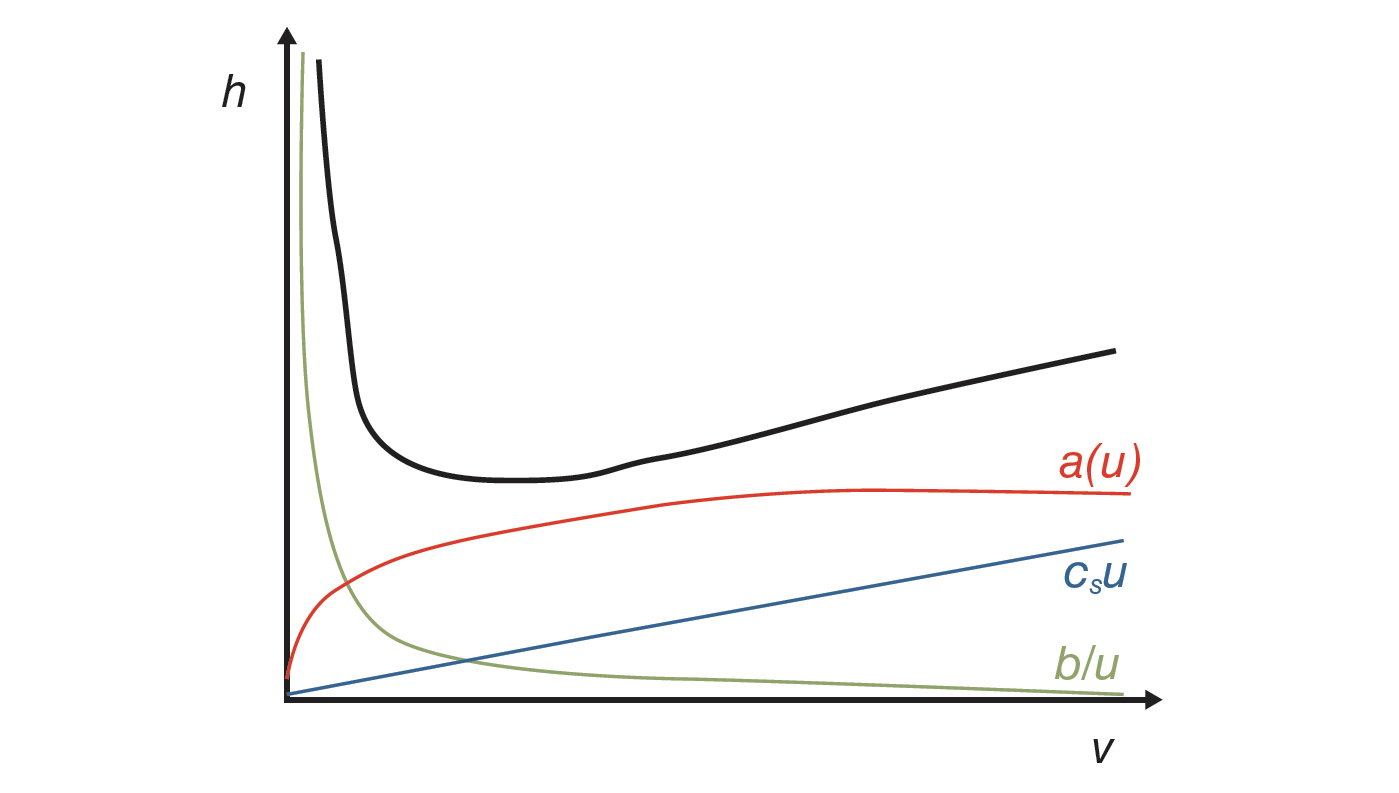Evaluation of PGC Stationary Phases Under High-Temperature LC Conditions for the Analysis of Parabens in Food Samples
Porous graphitic carbon (PGC) columns for liquid chromatography (LC) represent an alternative to octadecyl‐bonded silica columns for the separation of both polar and nonpolar molecules. This is accomplished by exploiting the polarizability of the stationary phase interacting with the functional groups of the analytes. However, the elution of nonpolar compounds requires a high percentage of organic solvent, losing the intrinsic advantage of reversed‐phase aqueous separations. In this article, we aimed to exploit an additional advantage of such columns, viz. the resistance at high temperatures. Superheated water was employed as the mobile phase, taking advantage of the decrease in water dielectric constant by increasing the temperature. In this context, our goal was to minimize the percentage of organic solvent utilizing high temperatures (up to 250 °C) to achieve fast and “green” separations. The new developed high‐temperature LC instrument was applied to the analysis of parabens in food samples.
Porous graphitic carbon (PGC) columns have been historically proposed as an alternative to both reversed-phase liquid chromatography (LC) and hydrophilic interaction liquid chromatography (HILIC) for the separation of many classes of chemical compounds, from small analytes to larger molecules, covering a wide range of polarity.
Chromatography system in chemical lab | Image Credit: © Sergey Ryzhov - stock.adobe.com
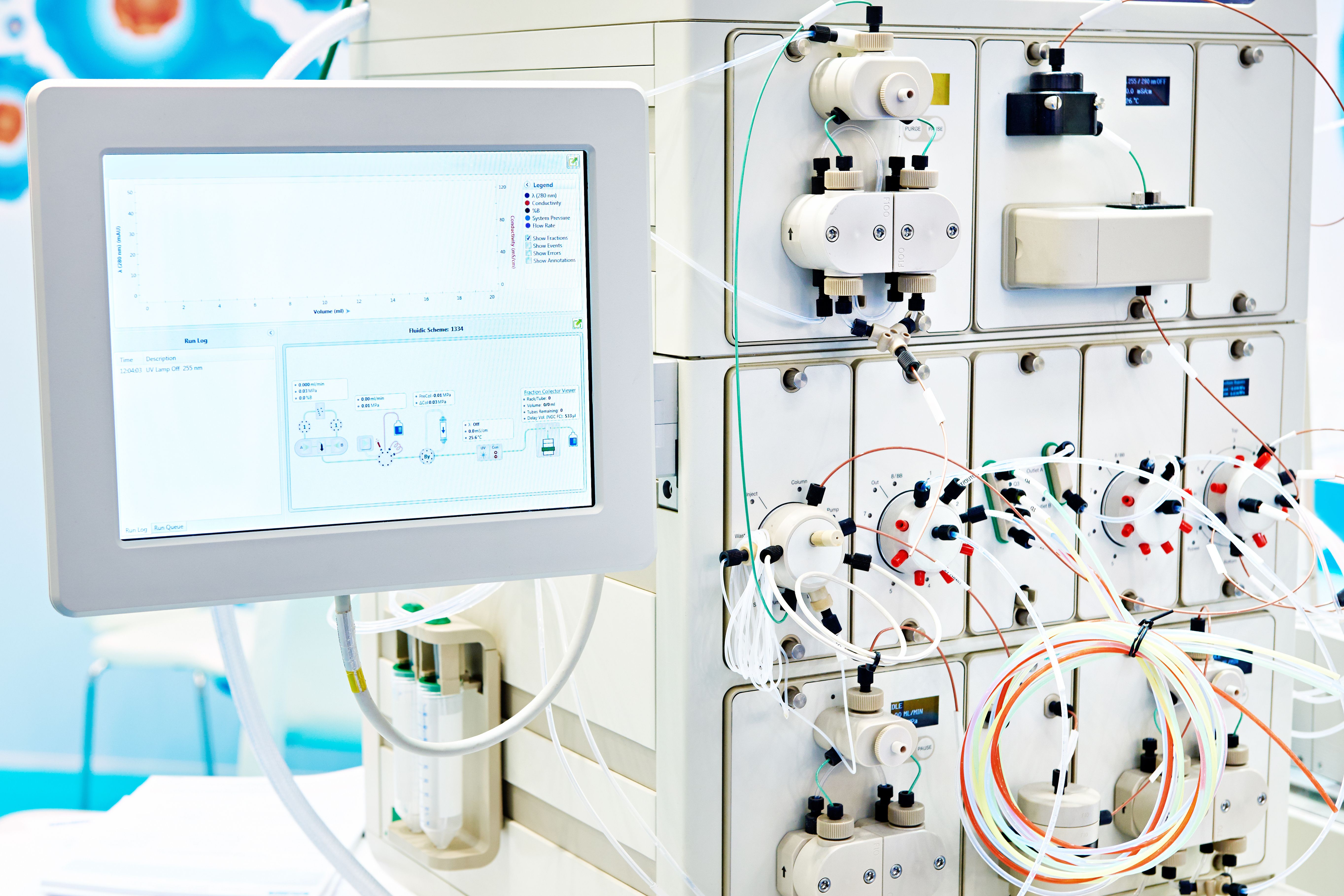
The main advantages of PGC materials are represented by their stability at very high temperatures (≥ 200 °C) in a wide pH range (1–14), and the absence of free silanol groups, which can alter the retention properties of the analytes. In more detail, the leading theory explaining the retention of the analytes on PGC surfaces is due to the polarizability of such stationary phases when close to polar analytes (referred to as polar retention effect on graphite, PREG) (1,2). Analyte size and shape also contribute to retention, as an increase in surface area contact will increase the analytes affinity to the surface, hence increasing retention time (2). This latter factor becomes prominent for the retention of aromatic and hydrophobic compounds, for which the primary interactions are based on π-π forces. In fact, hydrophobic compounds are normally retained more strongly on PGC columns compared to octadecyl phases (C18), especially if aromatic rings are present in their chemical structures (3). On the other hand, polar compounds, which are usually unretained under reversed-phase conditions, can be satisfactorily separated depending on molecule dimension and stereochemistry (4). Most of the work in the literature has employed these columns for the separation of polar or medium polar analytes, for example, sugars, peptides, glycopeptides, glycoside terpenes, and glucocorticoids (5–9). Aromatic compounds with high hydrophobic character experience strong retention on PGC columns, but this has been mitigated by using higher temperature or nonaqueous mobile phases, as in the case of triazine herbicides (10) and triacylglycerols (11). Interestingly, Cassel et al. (12) reported the use of PGC for the separation of polyglycerol fatty esters and fatty ethers, highlighting that, despite a significantly higher retention factor on the PGC column compared to C18, PGC was successful in discriminating between diastereomers. However, as a result of the high retention, the mobile phase was composed of mainly organic solvents, thus losing one important benefit of standard reversed-phase LC separation, which typically employs a high amount of water.
To overcome such limitations and to address the need for green analytical methodologies, the use of high-temperature aqueous separation has been explored. In an earlier study, the use of superheated water was proposed by exploiting the decrease in the dielectric constant of water with increasing temperature. At elevated temperatures of 200 °C and above, the eluotropic strength of water increases and is comparable to that of strong organic solvents in reversed-phase LC, for example, methanol, ethanol, or acetonitrile (13,14). To this regard, PGC columns can be conveniently used for high-temperature LC (HTLC) separations, as they showed thermal stability at temperatures above 200 °C.
Despite some early applications developed in the past (10,15), the main drawbacks are the lack of suitable instrumentation for the intended use, as well as the poor column reproducibility and robustness observed over time (16,17). It has been reported that column performances deteriorate due to mechanical stress over time and differences in the thermal expansion of the PGC stationary phase and the stainless-steel column hardware (17).
Recently, a novel, synthetic process was developed to create a small carbon particle (2.7-μm) surface with an extremely uniform particle size distribution, and a higher mechanical stability and reproducibility (18).
Within this context, one aim of the present work was to investigate the behaviour of such novel stationary phases to be used under high-temperature aqueous conditions. The robustness is a key parameter to propose them as an alternative approach to routine high performance liquid chromatography (HPLC) separations involving a huge consumption of organic and toxic solvent.
In the present work they were applied for the first time for the analysis of parabens, esters of p-hydroxybenzoic acid, commonly used as preservatives in the food and cosmetic industry due to their antimicrobial activity. Both in vitro and in vivo studies showed that parabens are endocrine-disrupting chemicals (19) and they represent a serious risk to human health. The rising incidence of breast cancer in women after topical exposure to paraben-containing body care products has been widely documented (20,21), as well as health complications in reproductive functions observed in men (22). For this reason, parabens have been strictly regulated in Europe since 1986 through the Commission Directive 86/199/CEE, which posed a maximum limit of 0.4% for single esters and 0.8% for a mixture of esters. Such limits were valid until 2009, according to Regulation (EC) No 1223/2009, but was amended by Commission Regulation (EU) N.1004/2014 due to new scientific evidence about the reproductive toxicity of some of these chemicals (19). According to these new studies, the Scientific Committee on Consumer Safety (SCCS) concluded that previous limits are only valid for short-chain parabens, for example, methyl and ethyl paraben, as well as their salts, while the content of longer chain parabens, for example, propyl and butylparaben, in cosmetic products must be below 0.14%.
In a similar way, all these concerns can be transferred to the exposure to food products containing parabens as preservatives. For many years no sufficient data were submitted regarding their acceptable daily intake (ADI), and methyl, ethyl, and propylparabens were used as food additives according to EC Directive 95/2/EC. This changed in 2008, when it was repealed by Regulation (EC) No 1333/2008, which only allowed the use of methyl and ethyl parabens as food additives. In fact, even when ingested, propyl paraben reduces the daily sperm production in rats, even at the lowest dose levels of 10 mg/kg body weight per day (23). Generally, the effect on the reproductive system becomes more prominent by increasing the length of the alkyl chain (24–26), while methyl and ethyl paraben did not significantly affect the reproductive organs (27).
To address the challenges above, there is a need for the development of a fast, sensitive, and accurate analytical method for the determination of parabens in real-world samples.
To this end, the official method is based on HPLC separation under reversed-phase conditions, using octadecyl-bonded silica columns and employing a mobile phase mixture of 5:60:10:25 (v/v) tetrahydrofuran–water–methanol– acetonitrile (28). The separation uses high amounts of organic solvent and requires around 15 min of total analysis time.
Alternative methods, faster and more efficient, have been developed over the years by the scientific community, involving both LC and gas chromatography (GC) separations. This increasing interest towards greener analytical approaches prompted the authors to test an HTLC setup for the analysis of parabens. The new setup required minimal organic solvent consumption compared to what is normally employed for HPLC separation (29,30), with no need for derivatization procedures—conventionally applied prior to GC analysis (31,32).
Experimental
Chemicals
Acetonitrile and ethanol (EtOH), both HPLC-grade, were acquired from Merck Life Science. Methyl paraben (MeP), ethyl paraben (EtP), propyl paraben (PrP), and butyl paraben (BuP) standard materials were also purchased from Merck Life Science, and standard solutions were prepared by mixing the four standards up to a total concentration of 250 ppm each in ethanol.
All water used was purified by Milli-Q Advantage A10 system equipment (Merck Life Science) and had an electrolytic conductivity lower than 60 nS/cm.
Samples and Sample Preparation
A sample of candies was acquired in a local market in Messina (Italy). For the extraction of the parabens, about 0.5 g of samples were weighed, homogenized, and dissolved in 3 mL of hot water (45 °C) and 2 mL of EtOH. The samples were sonicated for 2 min and subsequently filtered by passing through 0.45-μm membrane filters prior to injection.
HTLC Instrument and Chromatographic Conditions
The analyses were performed using a Flexar HPLC system (PerkinElmer) including a photo diode array detector (Flexar PDA Plus Detector), a quaternary LC pump (Flexar quaternary LC pump), and an autosampler (Flexar LC autosampler). It was coupled to a GC oven (MasterGC Dani Analitica) to hold the PGC column. A preheater tube, consisting of a 52 cm × 0.13 mm internal diameter (i.d.) stainless-steel tube wound around a hollow cylinder (~ 2 cm i.d.), was placed between the autosampler outlet and the column inlet to guarantee the fast and efficient heating of the mobile phase prior to entrance into the column. This reduced the gap between the temperature of the mobile phase coming from the injector and the one reaching the column.
At the column outlet a cooling system was necessary to cool the effluent from the column prior to entrance into the PDA cell. It consisted of a ventilated radiator water cooling circuit (Corsair Hydro Series H150i Pro), connected to the PC.
A cooling loop (56 cm L × 0.5 mm i.d. stainless-steel tube) was placed between the cooled head and a baseplate. The space between the baseplate and the loop was filled with carbon micro-particles, affording an extremely high thermal conductivity. The Corsair iCUE software was installed to monitor the temperature inside the cooling loop.
As for the LC conditions, chromatographic separation was achieved on a 50 × 3.0 mm, 2.7-μm Supel Carbon LC column provided by Merck Life Science.
Several combinations of water– acetonitrile and water–EtOH at different temperatures were tested to determine the minimum amount of organic solvent necessary to achieve a satisfactory separation in reasonable time. Injection volume was set at 1 μL and the sample was diluted to 250 ppm prior to analysis. The wavelength range of PDA was 190–400 nm, sampling frequency 6.25 Hz. Flow rate, oven temperature, and mobile phase composition were changed during column testing.
Chromatographic efficiency, resolution, retention time, width at 50%, and tailing factor at 5% were considered for the evaluation of system performance.
Results and Discussion
The present study aimed at the development of a “green” analytical methodology for the determination of parabens in food products. An HTLC setup was used to exploit the decrease in the dielectric constant of water by increasing the temperature, so that superheated water can be considered as a mixture water–organic solvent, thus reducing the percentage of the organic solvent necessary for the chromatographic elution. The starting point was represented by the paper by Dugo et al. (33), in which the authors employed a carbon-clad zirconia phase functionalized with octadecyl groups as stationary phase-resistant at high temperatures. Their goal was to achieve the separation of parabens by using only 5% of tetrahydrofuran (THF) as organic solvent in the mobile phase at a temperature of 170 °C. The total analysis time was around 17 min by using a 15-cm-long analytical column at a flow rate of 1 mL/min. The authors also demonstrated that a similar separation could be obtained on a conventional C18 column by using 40% of acetonitrile as organic solvent.
In the present application, the authors tried to reduce both the organic solvent toxicity and the total analysis time.
According to different selection guides for the “greenest” solvent, THF was not taken into consideration, as it was deemed hazardous by several ranking systems (34). For the initial tests, THF was replaced by acetonitrile, which is the most common organic solvent employed in reversed-phase LC, despite an univocal classification not existing for this solvent, which is sometimes recommended and considered usable, but other times problematic or hazardous.
As for the reduction of the analysis time, a 5-cm-long column was preferred over the 15 cm. Then, starting from the temperature of 170 °C, as in the work by Dugo et al. (33), 30% of acetonitrile was required to achieve the elution of parabens in a reasonable analysis time of 21 min at the optimal flow rate of 0.6 mL/min, as suggested by the column supplier. In fact, the high retentivity of PGC stationary phases employed in the present study towards aromatic analytes resulted in the need for higher eluent strength.
The obtained chromatogram is shown in Figure 1(a). Peak shapes and bandwidths are quite satisfactory for methyl and ethyl paraben (peaks 1 and 2), acceptable for propyl paraben (peak 3), while butyl paraben (peak 4) is considerably broadened due to its higher hydrophobicity (see Table 1).


However, PGC columns offer a unique advantage over more conventional stationary phases; their thermal stability up to 250 °C allows the retention of the analytes to be reduced and improves peak shapes. In fact, a temperature increase up to 200 °C—still maintaining 30% of acetonitrile in the mobile phase—allowed the analysis time to be halved, while reducing bandwidth and tailing factor (see Figure 1[b]).
It was then possible to decrease the organic solvent percentage up to 20% (Figure 1[c]), achieving chromatographic performances intermediate between conditions in Figure 1(a) and 1(b). It is noteworthy that the analysis at 20% of acetonitrile was performed at a flow rate of 1.2 mL/min. The use of a significantly higher flow rate with respect to the optimal flow suggested by the supplier was made feasible by taking into account the particle characteristics of the stationary phases tested, which resembled a monodisperse packaging with tight particle size distribution. Moreover, the use of very high temperatures led to a decrease in solvent viscosity, thus generating a considerably lower back pressure.
Table 1 summarizes the chromatographic performances of the system under different analytical conditions.
The further decrease of the organic solvent amounts by up to 10% significantly affected the chromatographic performance: propyl paraben (peak 3) was broadened while butyl paraben (peak 4) was no longer detected. Such results suggested that the decrease of the organic solvent percentage must necessarily be accompanied by an increase in the temperature. In fact, the comparison between the conditions of Figure 1(a) and 1(b) clearly showed, as at 30% of acetonitrile, a 30 °C increase in temperature led to a reduction of 50% of analysis time; on the other hand, the decrease of 10% of acetonitrile at 200 °C resulted in retention times three times higher. Finally, by operating the column at its maximum temperature of 250 °C, all peaks were eluted in less than 8 min with only 10% of organic solvent (Figure 1[d]).
It should be mentioned that at this temperature a minimum back pressure near 100 bar should be ensured inside the system to keep the water in its liquid state, therefore the use of a high flow rate (generating a back pressure of 100 bar) was mandatory in this work.
According to the authors’ aim of implementing a fully green analytical method, it was attempted to further reduce the organic solvent percentage; however, stronger retention was observed, resulting in a significant peak tailing.
A valid alternative strategy was the use of EtOH (or bio-ethanol) instead of acetonitrile, as it is a recommended and preferred solvent according to green chemistry rules (34).
The separation obtained under the same analytical conditions (250 °C mobile phase temperature, 10% organic solvent, and flow rate 1.2 mL/min) is reported in Figure 2, along with the table reporting the chromatographic parameters. It can be observed that the baseline was less noisy compared to previous analysis, thus significantly increasing the signal-to-noise ratio. This was possible thanks to the addition of a postcolumn restrictor (1.40 m L × 0.13 mm i.d. stainless-steel tube), which provoked an increase of the total back pressure of the system of about 30 bar and hindered the transition of the mobile phase into the gaseous state.
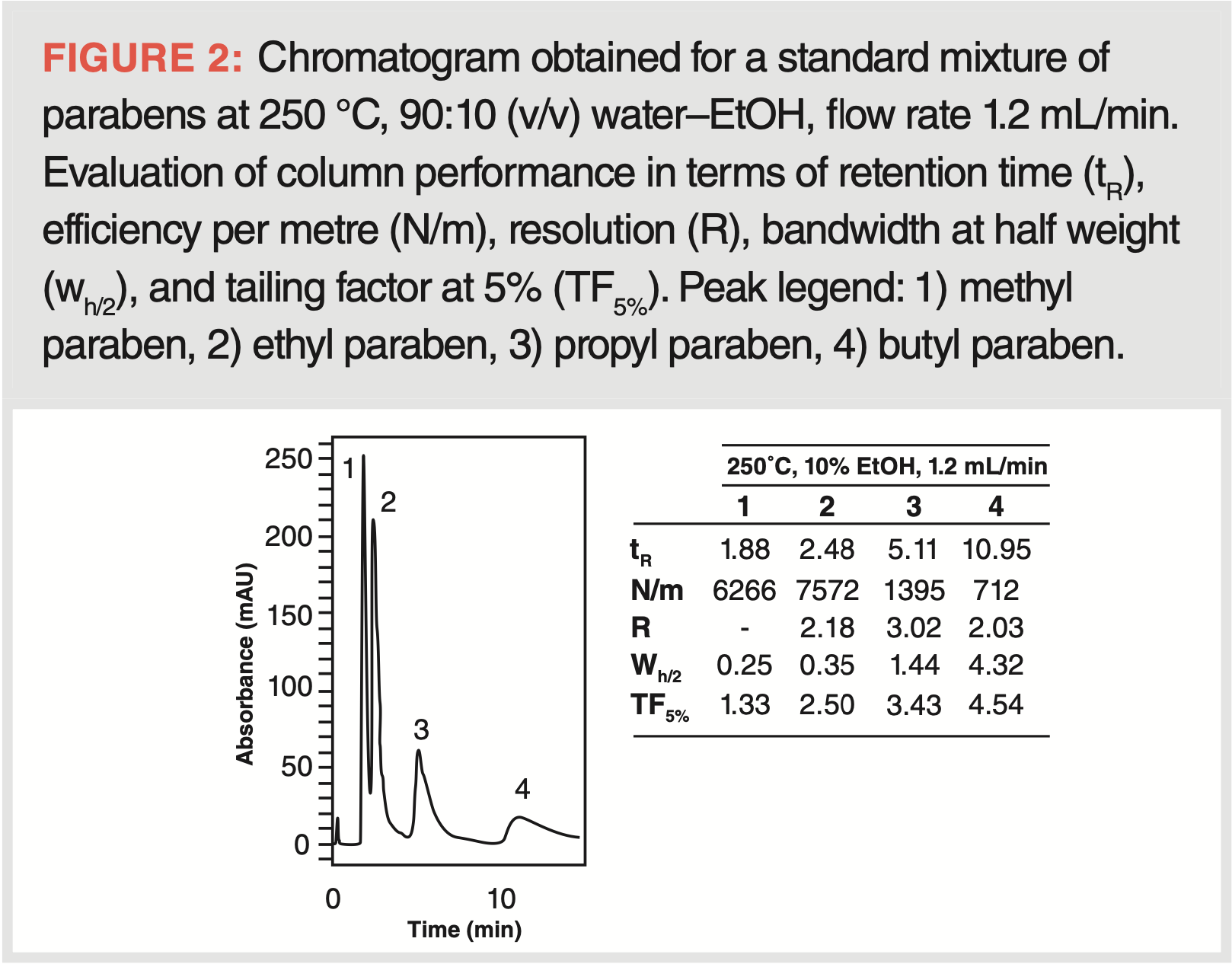
The replacement of acetonitrile with EtOH resulted in considerable peak tailing, with subsequent peak broadening for peaks 3 and 4. This effect can be explained in terms of the different elution properties of EtOH on the PGC phase, and its capability for hydrogen bonding. On the other hand, the triple bond in acetonitrile is capable of strong interactions with the graphitic surface.
A gradient step from 10 to 30% of EtOH, after 4 min of isocratic elution, was included in the method, and was finally applied to real sample analysis.
Figure 3(a) shows the chromatogram obtained for the paraben standard mixture, while Figure 3(b) reports the chromatogram obtained for the hydro-ethanolic extract of a candy sample. All peaks were satisfactorily separated and resolved, with improved resolution between peaks 1 and 2.
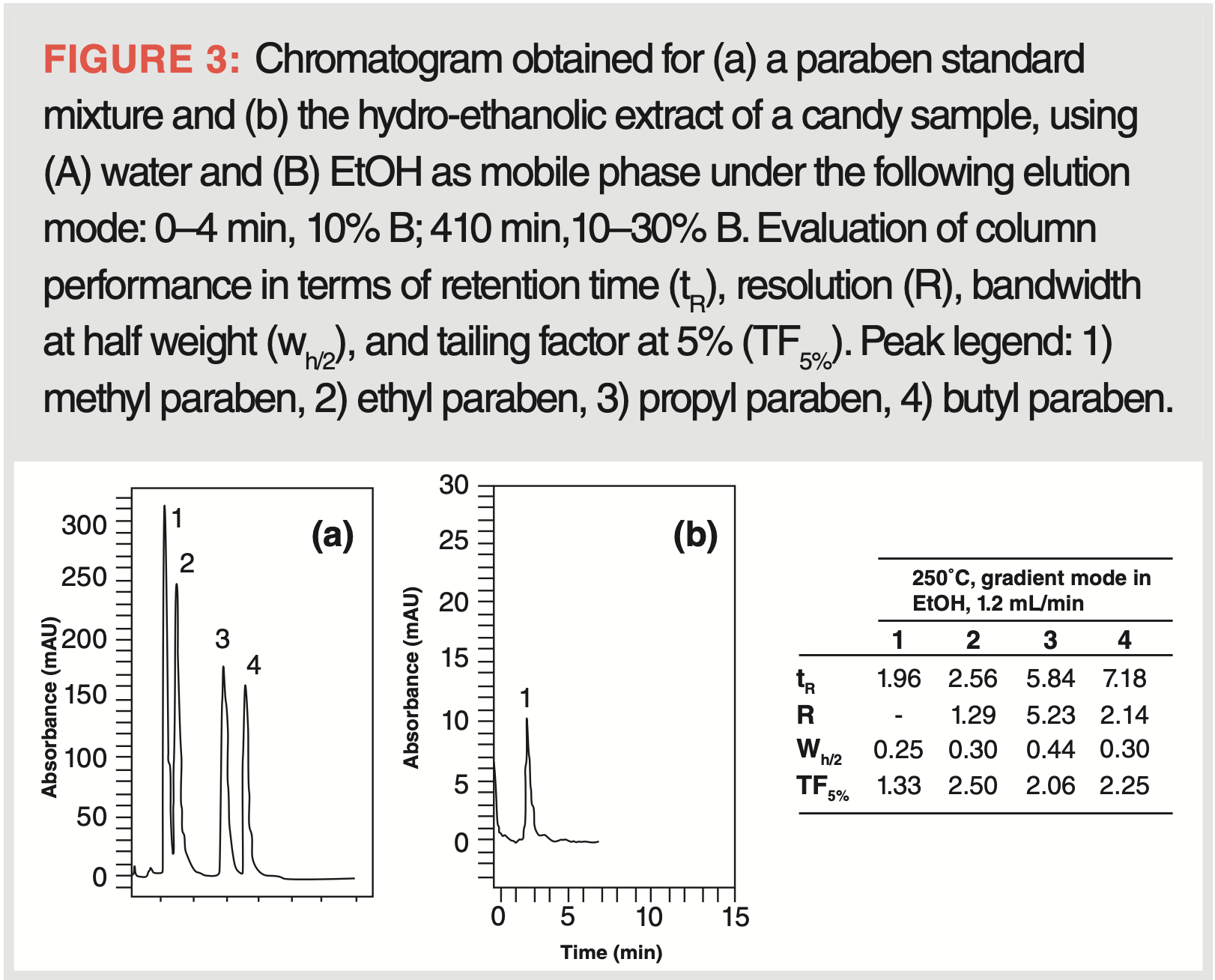
Conclusion
This work represents the first application of a new generation of PGC columns utilized under high temperatures of up to 250 °C. More than 240 analyses were performed, and a high repeatability was observed in terms of chromatographic performance (retention time, number of theoretical plates per metre, resolution, peak width, and tailing factor), thus assessing the robustness of the entire analytical method. Specifically, the HTLC setup was applied for the first time to the analysis of parabens in foodstuffs and a satisfactory separation was achieved in less than 10 min, with only a limited consumption of ethanol. Future efforts will address the validation of the developed method for application to both body care and food products, for the accurate detection of the maximum amounts allowed by current legislation.
In addition, it must be emphasized that this work has aimed to demonstrate the feasibility of the use of PGC columns in an HTLC setup through a rapid overview of the column performance under different experimental parameters, such as mobile phase, temperature, and flow rates, while systematically studying the effect of temperature on chromatographic performance for a wide range of analytes. Finally, an in-house HTLC instrumental setup was developed, which needs to be further evaluated in terms of robustness and effectiveness of each added component: the pre-heater, the cooler, and the restrictor.
Acknowledgements
The authors thank PerkinElmer Corporation for the continuous support.
Author Statement
FR is noted as corresponding author.
References
(1) West, C.; Elfakir, C.; Lafosse, M. Porous Graphitic Carbon: A Versatile Stationary Phase for Liquid Chromatography. J. Chromatogr. A 2010, 1217 (19), 3201–3216. DOI: 10.1016/j.chroma.2009.09.052
(2) Pereira, L. Porous Graphitic Carbon as a Stationary Phase in HPLC: Theory and Applications. J. Liq. Chromatogr. Relat. Technol. 2008, 31 (11–12), 1687–1731. DOI: 10.1080/10826070802126429
(3) De Matteis, C. I.; Simpson, D. A.; Euerby, M. R.; Shaw P. N.; Barrett, D. A. Chromatographic Retention Behaviour of Monosubstituted Benzene Derivatives on Porous Graphitic Carbon and Octadecyl-Bonded Silica Studied Using Molecular Modelling and Quantitative Structure–Retention Relationships. J. Chromatogr. A 2012, 1229, 95–106. DOI: 10.1016/j.chroma.2011.12.090
(4) Corman, C.; Muraco, C.; Ye, M.; Michel, F. Insights into the Shape-Selective Retention Properties of Porous Graphitic Carbon Stationary Phases and Applicability for Polar Compounds. LCGC Supplements 2023, 41 (s4), 16–19. DOI: 10.56530/lcgc.na.ms1373n8
(5) Caffrey, A. J.; Lafontaine, S.; Dailey, J; et al. Characterization of Humulus Lupulus Glycosides with Porous Graphitic Carbon and Sequential High Performance Liquid Chromatography Quadrupole Time-of-Flight Mass Spectrometry and High Performance Liquid Chromatography Fractionation. J. Chromatogr. A 2022, 1674, 463130. DOI: 10.1016/j.chroma.2022.463130
(6) Delafield, D. G.; Miles, H. N.; Ricke, W. A.; Li, L. Higher Temperature Porous Graphitic Carbon Separations Differentially Impact Distinct Glycopeptide Classes. J. Am. Soc. Mass. Spectrom. 2023, 34 (1), 64–74. DOI: 10.1021/jasms.2c00249
(7) Montone, C. M.; Capriotti, A. L.; Cerrato, A.; et al. Identification of Bioactive Short Peptides in Cow Milk by High-Performance Liquid Chromatography on C18 and Porous Graphitic Carbon Coupled to High-Resolution Mass Spectrometry. Anal. Bioanal. Chem. 2019, 411 (15), 3395–3404. DOI: 10.1007/s00216-019-01815-0
(8) Issaq, H. J.; Chan, K. C.; Blonder, J.; Ye, X.; Veenstra, T. D. Separation, Detection and Quantitation of Peptides by Liquid Chromatography
and Capillary Electrochromatography. J. Chromatogr. A 2009, 1216 (10), 1825–1837. DOI: 10.1016/j.chroma.2008.12.052
(9) Van den Hauwe, O.; Dumoulin, F.; Antignac, J. P.; et al. Liquid Chromatographic-Mass Spectrometric Analysis of 11 Glucocorticoid Residues and an Optimization of Enzymatic Hydrolysis Conditions in Bovine Liver. Anal. Chim. Acta 2002, 473, 127–134.
(10) Tajuddin, R.; Smith, R. M. On-Line Coupled Extraction and Separation Using Superheated Water for the Analysis of Triazine Herbicides in Spiked Compost Samples. J. Chromatogr. A 2005, 1084 (1–2), 194–200. DOI: 10.1016/j.chroma.2004.10.034
(11) Merelli, B.; De Person, M.; Favetta, P.; Lafosse, M. Analysis of Triacylglycerols on Porous Graphitic Carbon by High Temperature Liquid Chromatography. J. Chromatogr. A 2007, 1157 (1– 2), 462–466. DOI: 10.1016/j.chroma.2007.05.005
(12) Cassel, S.; Chaimbault, P.; Debaig, C.; et al. Liquid Chromatography of Polyglycerol Fatty Esters and Fatty Ethers on Porous Graphitic Carbon and Octadecyl Silica by Using Evaporative Light Scattering Detection and Mass Spectrometry. J. Chromatogr. A 2001, 919 (1), 95–106. DOI: 10.1016/s0021-9673(01)00801-9
(13) Kephart, T. S.; Dasgupta, P. K. Superheated Water Eluent Capillary Liquid Chromatography. Talanta 2002, 56, 977–987. DOI: 10.1016/s0039-9140(02)00049-8
(14) Mao, H.; Qiu, Z.; Xie, B.; et al. Development and Application of Ultra-High Temperature Drilling Fluids in Offshore Oilfield Around Bohai Sea Bay Basin, China. Offshore Technol. Conf. Asia 2016, OTCA 2016 2016, OTC-26384-MS, 1201–1222. DOI: 10.4043/26384-ms
(15) Kot, D.; Macko, T.; Arndt, J. H.; Brüll, R. Porous Graphite as Platform for the Separation and Characterization of Synthetic Polymers – An Overview. J. Chromatogr. A 2019, 1606, 360038. DOI: 10.1016/j.chroma.2019.02.029
(16) Heinisch, S.; Rocca, J. -L. Sense and Nonsense of High-Temperature Liquid Chromatography. J. Chromatogr. A 2009, 1216 (4), 642–658. DOI: 10.1016/j.chroma.2008.11.079
(17) Smith, R. M. Superheated Water Chromatography - A Green Technology for the Future. J. Chromatogr. A 2008, 1184 (1–2), 441–455. DOI: 10.1016/j.chroma.2007.07.002
(18) Corman, C.; Muraco, C.; Ye, M.; Frantz, C.; Maule, W. Applications of Newly Developed 2.7 μm Porous Graphitic Carbon Particles in U/HPLC. Sci. & Techn. Innov. Analytix Report 2021, 10, 3–7.
(19) Darbre, P. D.; Harvey, P. W. Paraben Esters: Review of Recent Studies of Endocrine Toxicity, Absorption, Esterase and Human Exposure, and Discussion of Potential Human Health Risks. J. of Appl. Toxicol. 2008, 28 (5), 561–578. DOI: 10.1002/jat.1358
(20) Darbre, P. D.; Aljarrah, A.; Miller, W. R.; et al. Concentrations of Parabens in Human Breast Tumours. J. of Appl. Toxicol. 2004, 24 (1), 5–13. DOI: 10.1002/jat.958
(21) Harvey, P. W.; Everett, D. J.; Significance of the Detection of Esters of p-hydroxybenzoic Acid (Parabens) in Human Breast Tumours. J. of Appl. Toxicol. 2004, 24 (1), 1–4. DOI: 10.1002/jat.957
(22) Mendiola, J.; Moñino-García, M.; Vela-Soria, F.; et al. Urinary Concentrations of Parabens and Reproductive Parameters in Young Men. Sci. of the Tot. Environ. 2018, 621, 201–209. DOI: 10.1016/j.scitotenv.2017.11.256
(23) Oishi, S. Effects of Propyl Paraben on the Male Reproductive System. Food and Chemical Toxicology 2002, 40, 1807–1813. DOI: 10.1016/s0278-6915(02)00204-1
(24) Routledge, E. J.; Parker, J.; Odum, J.; Ashby, J.; Sumpter, J. P. Some Alkyl Hydroxy Benzoate Preservatives (Parabens) Are Estrogenic. Toxicol. Appl. Pharmacol. 1998, 153, 12–19. DOI: 10.1006/taap.1998.8544
(25) Byford, J. R.; Shaw, L. E.; Drew, M. G. B.; et
al. Oestrogenic Activity of Parabens in MCF7 Human Breast Cancer Cells. J. of Steroid Biochem. & Molecul. Bio. 2002, 80, 49–60. DOI: 10.1016/s0960-0760(01)00174-1
(26) Okubo, T.; Yokoyama, Y.; Kano, K.; Kano, I. ER-Dependent Estrogenic Activity of Parabens Assessed by Proliferation of Human Breast Cancer MCF-7 Cells and Expression of ERa and PR. Food and Chemical Toxicology 2001, 39, 1225–1232. DOI: 10.1016/s0278-6915(01)00073-4
(27) Oishi, S. Lack of Spermatotoxic Effects of Methyl and Ethyl Esters of p-hydroxybenzoic Acid in Rats. Food and Chemical Toxicology 2004, 42 (11), 1845–1849. DOI: 10.1016/j.fct.2004.06.015
(28) Seventh Commission Directive 96/45/EC of 2 July 1996 Relating to Methods of Analysis Necessary for Checking the Composition of Cosmetic Products (Text with EEA Relevance). Official Journal 1996, L 213, 8–15. ELI: https://op.europa.eu/en/publication-detail/-/publication/ db4c4a8f-3272-45ff-b39e-41f6e0fa454d
(29) Maher, H. M.; Alzoman, N. Z.; Almeshal M. A.; et al. Quantitative Screening of Parabens in Ready-to-Eat Foodstuffs Available in the Saudi Market Using High Performance Liquid Chromatography with Photodiode Array Detection. Arabian J. of Chem. 2020, 13 (1), 2897–2911. DOI: 10.1016/j.arabjc.2018.07.019
(30) Zgoła-Grześkowiak, A.; Jeszka-Skowron, M.; Czarczyńska-Goślińska, B.; Grześkowiak, T. Determination of Parabens in Polish River and Lake Water as a Function of Season. Anal. Lett. 2016, 49 (11), 1734–1747. DOI: 10.1080/00032719.2015.1120739
(31) Saraji, M.; Mirmahdieh, S. Single-Drop Microextraction Followed by In-Syringe Derivatization and GC-MS Detection for the Determination of Parabens in Water and Cosmetic Products. J. Sep. Sci. 2009, 32 (7), 988–995. DOI: 10.1002/jssc.200800635
(32) Shanmugam, G.; Ramaswamy, B. R.; Radhakrishnan, V.; Tao, H., GC–MS Method for the Determination of Paraben Preservatives in the Human Breast Cancerous Tissue. Microchem. J. 2010, 96 (2), 391–396. DOI: 10.1016/j.microc.2010.07.005
(33) Dugo, P.; Buonasera, K.; Crupi, M. L.; et al. Superheated Water as Chromatographic Eluent for Parabens Separation on Octadecyl Coated Zirconia Stationary Phase. J. Sep. Sci. 2007, 30 (8), 1125–1130. DOI: 10.1002/jssc.200600406
(34) Prat, D.; Hayler, J.; Wells, A. A Survey of Solvent Selection Guides. Green Chem. 2014, 16 (10), 4546–4551. DOI: 10.1039/c4gc01149j
About the Authors
Roberta La Tella is a postdoctoral researcher in analytical chemistry at the University of Messina.
Francesca Rigano is an assistant professor of food chemistry at the University of Messina.
Clinton R. Corman is a senior scientist in the Analytical Research & Development team at MilliporeSigma.
Gabriel A. Odugbesi is a senior scientist in HPLC Analytical Research and Development at MilliporeSigma.
Paola Donato is an associate professor of analytical chemistry at the University of Messina.
Paola Dugo is a full professor of food chemistry at the University of Messina.
Luigi Mondello is a full professor of analytical chemistry at the University of Messina, and a member of the EAB for LCGC Europe.
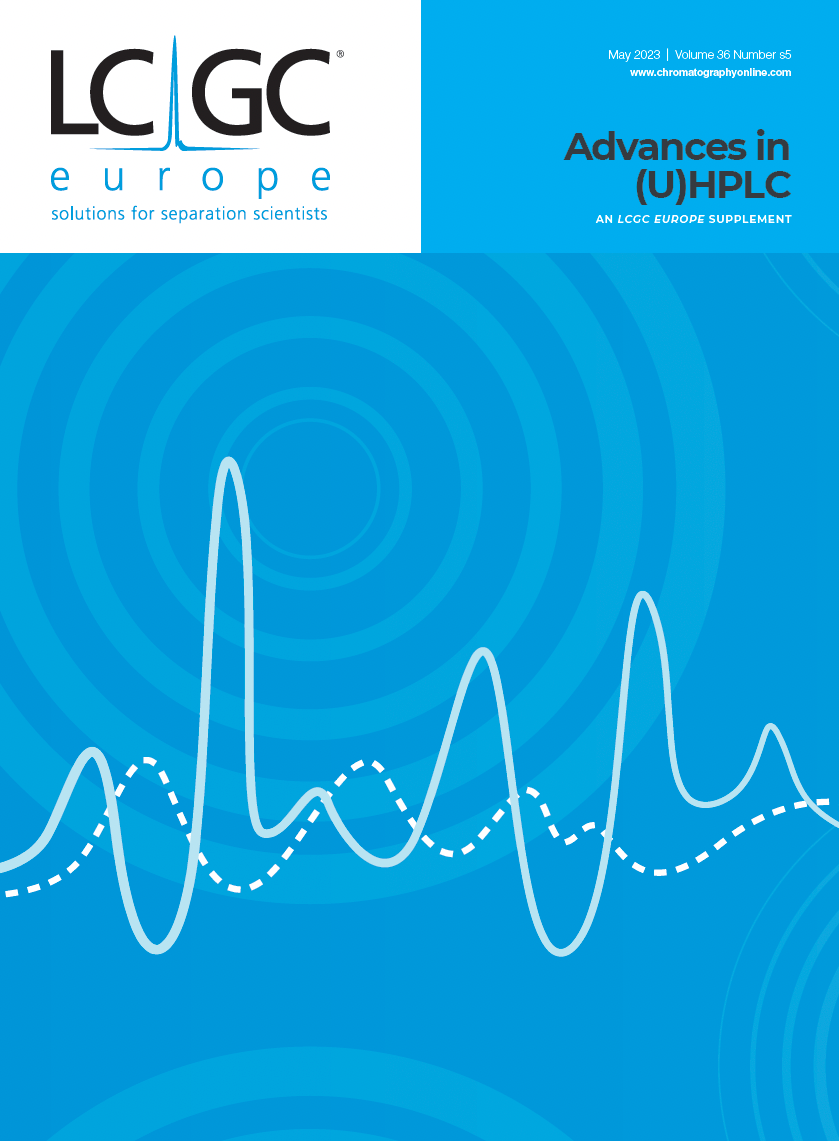
Analytical Challenges in Measuring Migration from Food Contact Materials
November 2nd 2015Food contact materials contain low molecular weight additives and processing aids which can migrate into foods leading to trace levels of contamination. Food safety is ensured through regulations, comprising compositional controls and migration limits, which present a significant analytical challenge to the food industry to ensure compliance and demonstrate due diligence. Of the various analytical approaches, LC-MS/MS has proved to be an essential tool in monitoring migration of target compounds into foods, and more sophisticated approaches such as LC-high resolution MS (Orbitrap) are being increasingly used for untargeted analysis to monitor non-intentionally added substances. This podcast will provide an overview to this area, illustrated with various applications showing current approaches being employed.
Extracting Estrogenic Hormones Using Rotating Disk and Modified Clays
April 14th 2025University of Caldas and University of Chile researchers extracted estrogenic hormones from wastewater samples using rotating disk sorption extraction. After extraction, the concentrated analytes were measured using liquid chromatography coupled with photodiode array detection (HPLC-PDA).





